When I first joined SparkFun I was but a wee lad. Okay, I was 26 years old and 6 foot 3 inches tall...so not very wee or laddish. However, it does seem like a generation ago. But I digress. In those early days, in the early autumn of 2006 to be more precise, SparkFun itself was much smaller in scope than the organization that has since grown up around us. This is the story of how SparkFun's production crew has developed (some might say improved) over the years by taking chances, learning from our mistakes, and being willing to try new assembly methods, component types/packages, and processes…
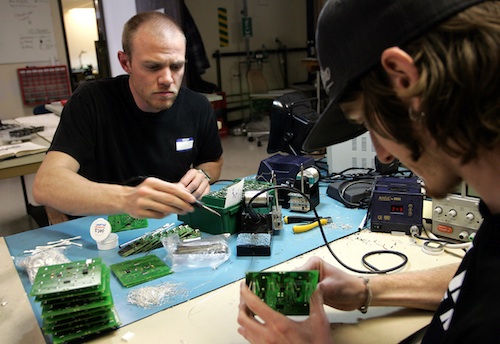
Tyler and I soldering away at our first production facility circa 2007.
Many of you have heard the story of the reflow skillet
.:: Side note: I'm wondering if any of those early boards (any SparkFun-built board purchased before August/September of 2006) are still in use at someone's workbench or in their embedded project. If so, please send us a note
to tell us if it still works and in what way it is being used. ::.
But Nate soon realized that he wanted to be able to assemble more boards than the skillet (or even two) would allow, regardless of how many hours he kept those skillets fired up. And a good argument could be made that yields would certainly improve with tools and training that were geared specifically for the task of populating PCBs. We were lucky enough to have an office neighbor in our first office building that was winding down his business and had an old reflow oven that he wanted to part with. So we hooked it up and started playing with reflow profiles, not really even knowing if the oven was properly calibrated. We, admittedly, were not experts on PCB assembly in these days but we all loved what SparkFun stood for and the environment we were given in which to build and learn. We valued the opportunity to perfect our craft, focusing intently as we built upon the early lessons learned through some good, old-fashioned trial-and-error. We like to think that we've made great strides in the overall quality and volume of circuit boards that we are now building for you all, SparkFun Nation (yes, Colbert influenced)
, for use in your own uniquely amazing experiments, prototypes, projects, and for general exploration.
So what has changed since those early days? The basic concept of producing widgets that utilize small electronics components, custom designed PCBs, and some solder with a healthy dose of high heat really has not changed. However; the equipment we use has grown more complex and specialized, allowing us to build more intricate boards…and many more of them. The number of boards we now assemble on a daily/weekly/monthly basis is far greater than what we were capable of 5 years ago. So far this year (through the end of September), we have averaged the production of 14,000+ "widgets" (defined as everything from breakout boards to kits) per week. Whoa! Seriously?! I still have a hard time believing that we've scaled to this level in only a few short years. To offer a greater perspective, I recently found an old spreadsheet saved in some obscure folder on my hard drive that was once used to track our daily and weekly throughput and yields. Taken from this spreadsheet, for comparison purposes, consider that during the week of December 4th-9th, 2006, SparkFun made a whopping 458 widgets in total. So, defined this way, we’re now significantly more productive than we were back then. But if you look at the total number of boards we built that week, you’ll notice that only roughly 80% of what we actually built could be made to function. Again, for comparison purposes, our average yield throughout all of 2011 has been 99.58%!
Additionally, the number of production employees, the number of components in our inventory, and the square footage of our workspace has increased, in dramatic fashion, during the last 5 years. I remember when our inventory storage consisted of a single bin storage rack on casters where we stored our PCBs and some wire shelving that held 3 boxes (Boxes A, B, & C) that each held a mish mash of random parts in their original Digi-Key packaging. Reels of components? Forget it. "5,000 0.1uF capacitors would take us forever to use up!"
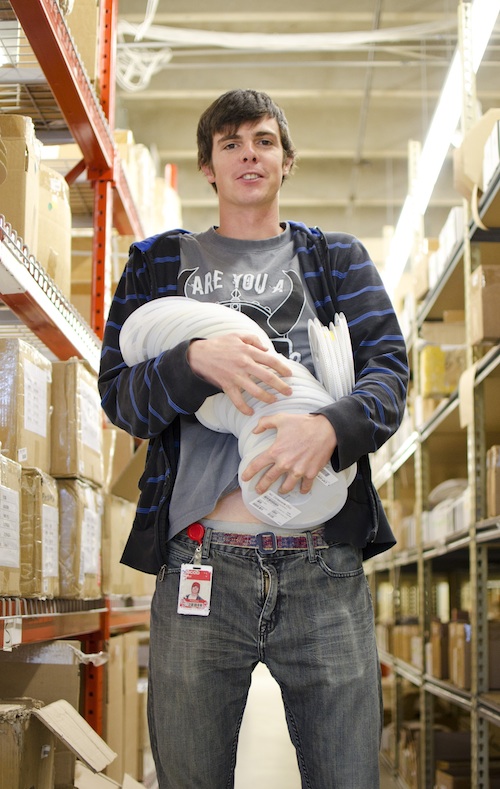
We now order 200,000pcs (50 x 4,000pc reels) of 0.1uF capacitors at a time.
When I first started here, we didn’t have a SKU system to help keep our inventory organized. And our BOMs (Bill of Materials) were simply translated by hand from the assembly sheet that was printed from Eagle onto the margin of the assembly sheet.
But I'll never forget the time that Nate wanted to know why I was asking our purchaser to order 500 Bluetooth modules. Then when I showed him how many BlueSMiRFs we were building/selling per week, his jaw dropped and with a shrug of his shoulders he pulled out his credit card to make it happen.
My first year with SparkFun saw the production space consuming all of about 1,400 square feet. Back then, we looked a lot more like the few hackerspaces I’ve seen. A few tables, 3 or 4 computers for testing, some soldering irons, a wall of shelving that held our components and parts, a table in the corner to stencil boards on, a reflow oven, and a pick-and-place machine. To be honest, our feng shui sucked...and we loved it just the way it was! There was no assembly line. We didn’t have space for one! We just worked with what we had.
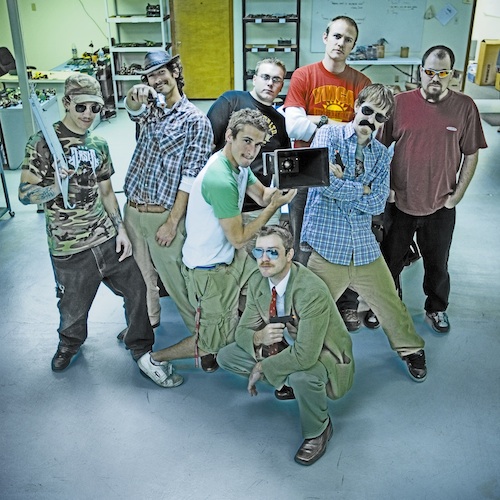
Guns not real. Mustaches however...
But as time went on and as our need for more space grew, we expanded our square footage and began hiking down the road of improved efficiency. It’s probably important to note here that some might see efficiency as a negative, a culture killer. But we try to look at improvements in the efficiency arena as improvements in the name of sustainability. We can’t really expect that moving to a larger space every 2 years is going to scale as well as finding smarter ways to utilize our space and time. At a certain point, some level of automation just makes sense.
So in early 2007, we decided to explore the feasibility of and capabilities that a pick-and place machine could provide us. Apart from wanting to play with such an awesome machine, we were hopeful that it would also help us catch up to the demand of our more popular breakout and dev boards. Over the next 2 years, we learned how to use this machine and how to manage the production of a growing number of board designs by utilizing its speed and accuracy. We suddenly found ourselves in this strange hybrid space of medium volume assembly of some designs and resolutely low volume of others. And, all the while, the number of different board designs we assembled continued to grow on nearly a weekly basis. By 2008 we had started up a full night shift operation of the pick-and-place (PnP) machine. And then in late 2009, we brought on a second PnP machine because we were struggling mightily to keep up with the growth in demand of SparkFun designed and built boards. Our two PnP machines (Optimus Prime and Megatron) are run each day and night by 6 incredible guys whose attention to detail results in extremely high quality board assembly, often with very little touch-up rework required.
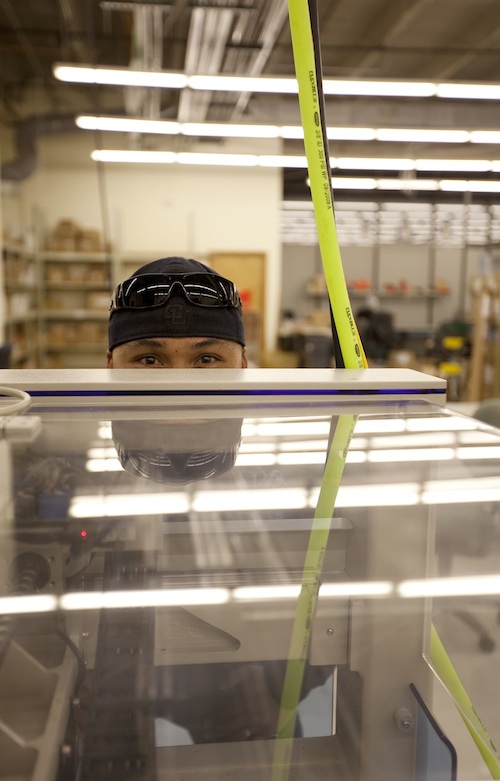
Gerry makes sure Optimus Prime and Megatron are running at top speed every night.
Just as automated assembly was a monumental shift for us back in ‘07, we experienced an equivalent paradigm shift during the same year when we made the decision to start building kits as part of our assembly line-up. Up until that time, we already were selling items that were kits at their very essence. But they weren’t being pieced together until an order for one was placed. Managing kit products this way was slowing down our shipping department. So we welcomed a couple of kits to our production family. But in 2009, we decided to really put our money where our mouth was and hired our first full-time kitter. There is another blog post currently in the works that will share more details about the development of our kitting operations. But I will say this about our in-house kitting operation...kits and retail products now constitute 30-40% of the total number of widgets built at SparkFun every week. Our kitting crew members do an amazing job, putting together thousands of kits each week with a relatively very low error rate! If you’ve ever wondered what it would be like to build SparkFun kits all day, here is a speedy look at a typical build of 25 retail-ready SparkFun Inventor’s Kits...!
But lest we forget our roots...it’s important to return to the idea that SparkFun’s own production capabilities came about because it was important to us to be able to try out circuit board assembly for ourselves and share with the world what we learned along the way. We continue to pride ourselves on our ability to stencil, populate, and rework (by hand) every board built here at our home base in Boulder. And while we’re still capable of truly hand-built boards, our extremely talented assembly technicians have done an incredible job of adjusting over the years from doing a heavy amount of hand populating boards to becoming experts in testing and rework so that they can keep up with the pace of our two pick-and-place machines that are each running 80 hours per week.
And, while we’re on the topic of testing, we continue to see many of our most significant efficiency gains realized because of the continued improvements being made by our test developers. Whereas, we once had a few different testbeds built up that would test a handful of different boards. Now almost every board design has its very own unique testbed, most of them cleverly designed pogobeds.
As we've grown and progressed, we've continued to redraw the lines for both what we are capable of and what we want to be. In the small electronics assembly world, success or failure can be defined in a number of ways. Are you building your widgets cheaper and faster than everyone else in the world? Will your customers know you for having the highest quality boards and kits? Or do you have the capability to spin up custom built boards to someone else's precise specifications…while also doing so cheaper and faster than the next guy? Most likely none of these statements apply to us, though if I had to choose, I would love for us to be viewed as a top quality manufacturer. But I do believe wholeheartedly that we have built up a strong connection to the end users of the widgets built here within the four walls of 6175 Longbow Drive and that this connection and the way we offer up genuine support to this unique community is what continues to set us apart from the more advanced contract manufacturers out there. This community support plays out in a number of tangible ways: teaching what we've learned about PCB assembly through soldering and stenciling workshops, opening our doors to the outside world as often as possible to anyone interested in seeing our hard work in action, and posting tutorials on how we test 100% of our assembled boards via uniquely custom designed pogo beds. Like the rest of SparkFun, we are more than happy to share what we've learned and are even open to telling you where we messed up in the process, painful as that may be sometimes.
If I had to narrow down our list of lessons learned to a top 5, I think it would look something like this:
- Do not store bare, unpopulated PCBs in the open air. It doesn’t matter how dry the Colorado air is, there is still enough moisture present to corrode those pads over time if left exposed.
- Document. Document. Document. As we grew, it became apparent that we were not going to be able to remember all of the small build or test techniques that would enable us to assemble a growing mix of boards and kits if those special instructions were locked away in the heads of just a few.
- Retain at least 1 “known good” board in the shop for sanity checking when a batch of boards has repeatedly failed our test procedure.
- Be scrappy where you can but don’t hesitate to get the right tool for the job if the scrappy solution delivers poor quality, low repeatability, or safety risks.
- Don’t be afraid to stand outside of our comfort zones when asked to play with new components or other materials. Solving unique assembly challenges are where the real fun is, anyway!
Despite the fact that we now use some very complex and fun equipment, like pick & place machines, reflow ovens, a PCA (printed circuit assembly) washer / defluxing system, and automated optical inspection (AOI) machine, to assemble SparkFun goodies; our team of creative, talented, and fun individuals love that we continue to have the opportunity to personally build up the boards and kits that you all love to play with. And we're excited to play our role of support in enabling you to dream bigger and to create what hasn't yet been invented for an application that is unique to you and your own adventures or challenges!
It’s very likely that I didn’t answer some of the questions that many of you might have. I’ll do my best to answer any questions posted in the comments below. And, perhaps more exciting (for those of you geeks that would love a little more dialogue on manufacturing processes), our IT crew is currently working on an expanded blog system that will create more avenues for generating content to share with the SparkFun community. This will pave the way for more production-related info to be shared with the world...
To end on a high note...back in March of this year, we delivered to “the storefront” the millionth widget built here at SparkFun! It was a milestone that we celebrated in true SparkFun fashion. And we’re already looking forward to 2 million (nearly halfway there already!)...
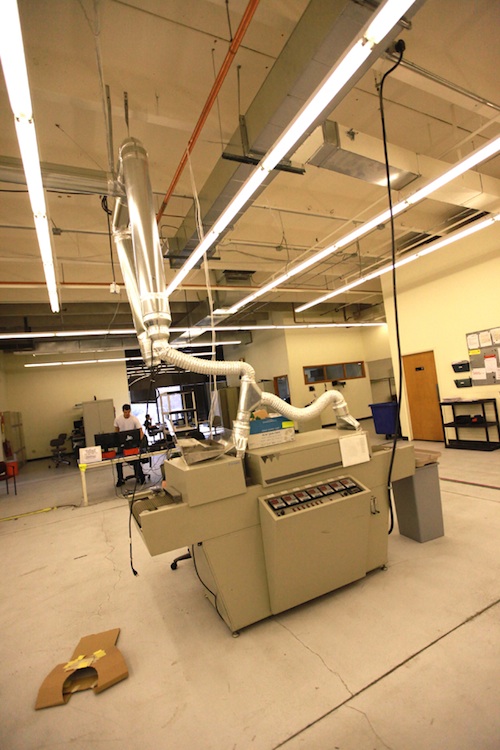
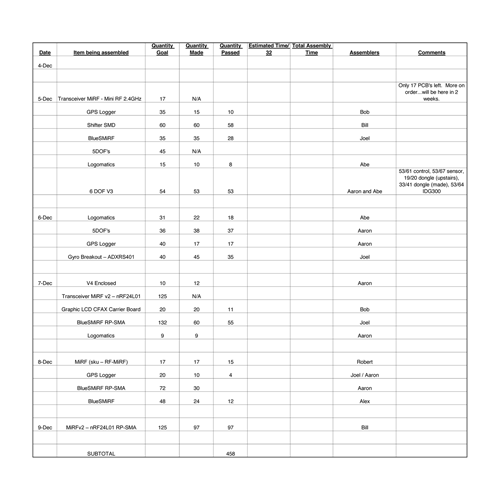
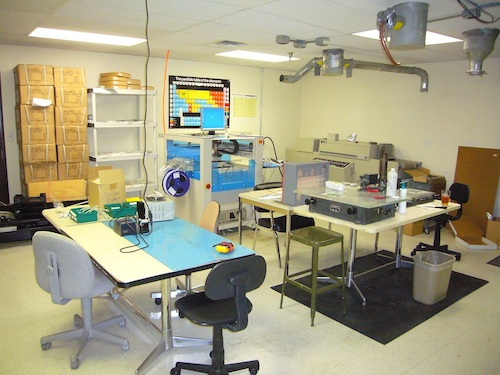
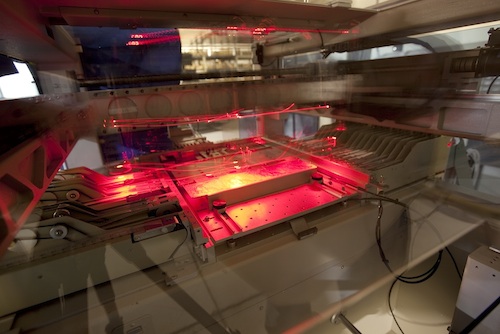
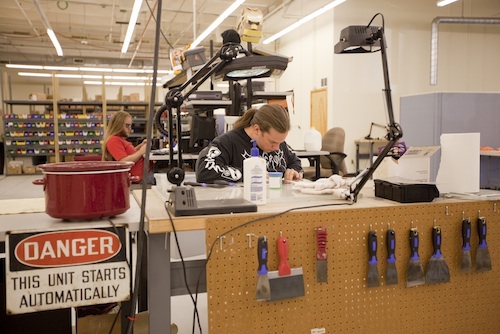
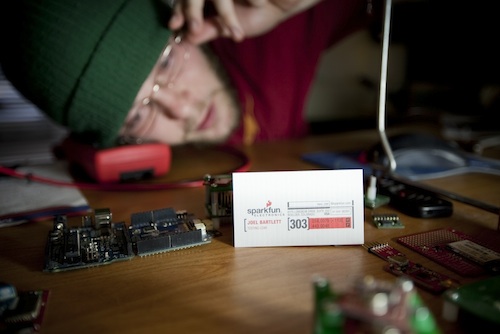
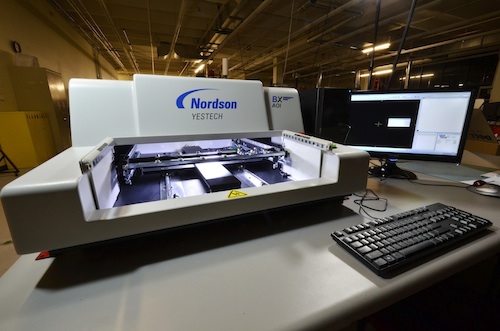
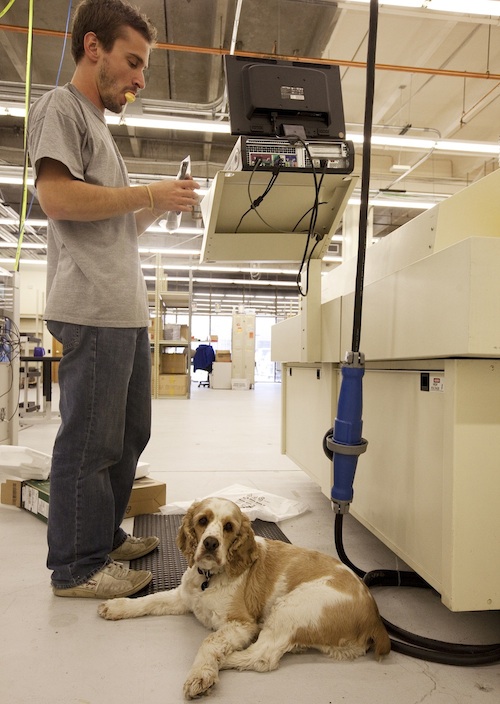
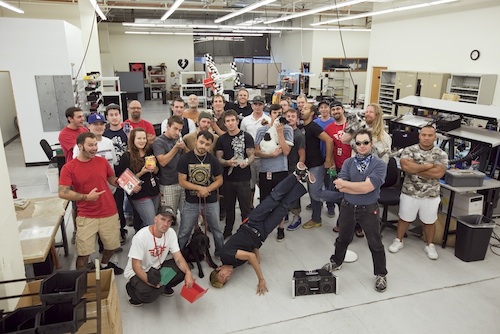
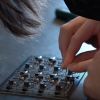
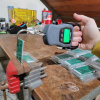








Are you accepting applications? My god, this is a dream job! I'd do it for free.
Not at this specific moment in time, but stay tuned...!
+1. Will you guys hire me once I graduate from HS?
Actually saw a woman. Weird.
This is both awesome and inspiring. It's fantastic to see a US company make a truly successful manufacturing business without "shipping it off to China."
Who knows, maybe in a few years you can beat out Foxconn for the iPhone 7 gig!
It's definitely something that I personally, and many of us here in the Production dept. are very proud of.
It's cool that SFE has it's employees bond over hot air guns! You never can change that. I am just surprised that you guys have not found a way to automate it, yet.
Also high on the Cool meter, you have a four footed morale officer. They are always good for a hug on a bad hair/part/programming day! They are also good at putting a cold nose where it's needed, even if you don't think so. And sometimes you can get them to do walkies when you need to get outside and smell the roses, when the PCBs are getting too hot to handle!
I just had to laugh at your Danger sign next to the crock pot. Somewhere there is an OSHA inspector shedding a tear.
Actually, since you mentioned it...the hot air guns used to apply heat shrink to the SparkFun Inventor's Kits HAVE been replaced. We brought in a used heat shrink tunnel a couple months ago to help speed up that step. But there are still plenty of other ways that we have of bonding together!
I LOVE this article! And someday, I'll even read it!
I think it's awesome how SFE is an open source company, through and through.
This is a bit late to the game but I have a few questions. I'm wondering do you do ALL your own assembly, or does your PCB manufacturer do some as well? I understand that you use Gold Phoenix. If they do some assembly for you, do you use their turnkey services, or do you provide them with the parts, and if it's the latter then how do you make sure everything is kept track of? I guess a lot of parts come from China, so I imagine you just ship them directly to the assembler? I'm just starting to get some products built, and am trying to figure out the best way to get this done. Also, at what quantity do you start using using pick and place? cheers.
Congratulations on your success timeline. Sometimes it's good to stop and look back, or to stop and see how big it is. Size doesn't necessarily correlate to happiness, so stop growing just short of anything that will make you stop fly fishing or whatever makes you happy in Colorado. I'm also glad to see you guys sponsor competitions and learning. Believe it or not, that is the key to your growth and your fan group. If you really want to skyrocket the way Parallax did, it's in making more tutorials and a good learning curriculum.
Keep up the good work! -Migs
Personally, snowboarding and cycling are where I find that happiness. And I'm taking my first snowboard runs of the season this Saturday! So I guess we're good to continue growing, if need be. :)
There will be no shortage of more classes and competitions in the next 5 years. Please let us know if you ever have new ideas in either category that you'd like to see...
Nice post! I think quality is very high. At least I've never had problems with any shipment. And your web page is great with tutorials and examples. I'm a SFE fan! :)
Thank you for the kind words! We will continue doing our best to keep our quality level high and letting the world know when we've failed to do so and why.
What an awesome group that made everything complicated to something can everyone use.
Along with everything else, I really enjoy receiving those very nice red boxes holding my order. Each box is re-used as a parts bin for my micro parts. Very nice ! Now if I could get a choice for size when ordering so they are all uniform.
thanks ... good job .... Bill
Now I really wanna invest in SFE! Is that possible yet? SFE could build robots from multiple Arduinos to automate it! And, they could sell the robot as a kit! Robots building robots!
Not possible, and personally I'm happy it isn't. As for the robots, I'd rather not be replaced by one!
Nate, you are very fortunate, that stems from Hard Work, Curiosity and Determination. you have the stuff that the people who made this country had. and the torch has been passed down to
the Geeks, Hackers and other "Makers of Things" to carry on those
Ideals.
You guys (and gals) have really come a long ways. I remember when you were still using the skillet for soldering. You convinced me that I could actually use SMD devices in my designs and solder them myself. I also remember when you were first using stencils and spreading the paste by hand. I suspect you've got a machine to do that for you now, too. I still haven't tried that (haven't needed to make enough boards to make it worth it). You all should be proud of how successful you've been.
I totally agree with your sentiment! I learned how to do SMD work following SparkFun's tutorials, and now I don't want to go back ;) It's also become a very useful skill, in high demand at the university research lab I work. Same thing with the Eagle tutorials as well :)
That's a warrior dash T-shirt!
What about an introduction to all/most of the team and a brief explination of their job, I always look at the pictures in the news feed and think "Who is that guy with the cool glasses?" so it would be nice to know who they are and what their purpose is.
Are you hoping for an introduction to everybody at SparkFun, or just the production department? I'm sure we could find a way to make this happen...
P.S. Nobody around here really seems to know who that guy with the cool glasses is. He just shows up on occasion and hangs out for awhile. ;)
As many as possible please, if you can only do 1 department they thats fine but if you can do the whole building then that would be epic.
What about the guy thats on a 45 degree angle in the last picture? He could be a good feature...
Mr. 45 Degrees is Bobby Chan, one of our newest assembly technicians. He and a few others around SparkFun are breakers (commonly known as break dancers though I learned that break dancer is the wrong term). They are amazing talented! Bobby is a recent grad of CU with a EE degree.
I'll see if we can put together a more formal "Meet the SparkFun Family" series of posts that tell the unique stories of those working here...
MountainMateo,
My first order with Sparkfun was in September of 2006, so I guess I started buying from SFE at the same time you started work there.
Thanks for one of the more interesting articles here.
You're welcome. Sounds like 2006 was a very good year for both of us!
I can't get Ubuntu 11.10 to work with the Reply button! I'm in Firefox... Does anyone know how to solve this?
Sounds weird to me. The Ubuntu part shouldn't really matter at all, it's all about browser version and settings. We're updating the comment system tomorrow, so maybe try again tomorrow night? Shift + refresh might fix your issue as well.
Also, you could try installing Chromium and see if the issue disappears in there.
Edit: Ran into a few IE issues that need to be dealt with.
Works now! Yay! And WTC is Chromium? I've heard of it but don't know what it is...
Chrome vs Chromium
There you go.
@Blacklab1: I liked the "Starts automatically" sign, too. And replacing counselors with dogs also means that the budget for that department can be reduced to the price of treats! Double win!
Hello,
Very good post ! I'm myself considering buying equipment for automated pcb assembly (PnP and oven), but my budget is pretty limited (10k€ would be ok).
Could you post some infos on what is important to check before buying a pick'n'place, how to use it, etc?
Madelltech has a pick'n'place automatic machine for pretty cheap, do you think it's a good idea (they made an offer for the PnP + accessories and oven at about 9k€)? I can still stencil by hand.
It's mainly for prototyping and very small batches (hundreds at max).
And I'd like more infos on how to solder parts on both sides (automated), PCBA told me it was easy to do ...
Regards,
Thomas.
Hi Thomas,
I'm Bob, the guy in the picture with the dog(Ranger) at his feet and something strange in his mouth...
I've been running our Pick and Place operations for a few years now and could probably give you some good info on what to look for in automation.
Some key factors:
What is your component range? If you have a lot of unique/specialty parts you will want to get a machine that has a good vision system for identifying that wide range of components for proper placement.
Are you building only a few types of boards or do you have a large variety of boards? If you have a large variety of boards to build you would want to look for something that has a fairly quick change over procedure so you can minimize downtime between designs.
How large are your boards/panels of boards? Obviously here you will want to make sure to get a unit that will support your dimensions.
Didn't have enough space in that first reply...
How quickly do you want to turn boards out? It sounds like speed isn't too much of a factor for you so this might not apply. But machines are commonly rated in CPH(components per hour). This serves as a maximum placement speed, basically if you had a single component placed over and over, it could do say 4,000 in an hour.
It's like your car, the spedometer goes to 140 but you never really go that fast. Same thing here, rated for 4,000 but you will more than likely see something around 2,000.
Hope this helps!
Ho by the way, I was reading your spreadsheet of a week time manufacturing in early 2006 ...
I have approx the same made/working ratio by default, that I increase a bit by a lot of rework (hence a lot of time).
The goal of using a PnP machine is also to increase this ratio as much as possible.
Are you looking at the DP2006 series?
Looks like it would be good for prototyping/low volume production. Maximum of 50 8mm feeders, might not be enough for your application?
Overall though it sounds like it would fit your needs.
Hello,
Thanks a lot for the reply !
The speed is not really important, but you are right saying the componant range is crucial ... I'm considering buying this equipment because my boards use more and more components that can hardly be placed by hand (bunch of 0402, small pitch QFN / QFP, I'd lile BGA, etc). For the board's sizes, range is from a few square mm to about 1 square inch, my last panel of 20 board for example is 15x13 cm.
As it's for prototyping, I will have a lot of different boards, probably often doing only one panel of prototypes.
About speed, my PCB manufacturer (SPCI in France, awesome job each time !) has a turn around time of approx 1 week for 4 layer PCBs, so if it takes 1 hours insteand of 30min to populate the boards, it really is not a problem ;)
What do you think about the madelltech small PnP, a good idea to start with ?
Best regards, Thomas.